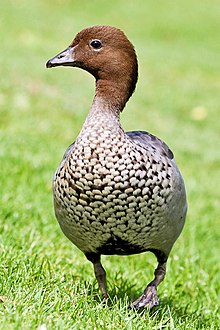Australian wood duck
| Australian Wood Duck | |
|---|---|

| |
| Adult male | |

| |
| Adult female | |
| Scientific classification | |
| Kingdom: | |
| Phylum: | |
| Class: | |
| Order: | |
| Family: | |
| Subfamily: | |
| Genus: | Chenonetta Brandt, 1836
|
| Species: | C. jubata
|
| Binomial name | |
| Chenonetta jubata (Latham, 1802)
| |
The Australian Wood Duck, Maned Duck or Maned Goose, Chenonetta jubata, is a dabbling duck found throughout much of Australia. It is the only living species in the genus Chenonetta. Traditionally placed in the subfamily Anatinae (dabbling ducks), it might actually belong to the subfamily Tadorninae (shelducks);[2] the Ringed Teal may be its closest living relative.[3]
Taxonomy
The flightless New Zealand species Chenonetta finschi (Finsch's Duck) which was formerly believed to constitute a monotypic genus (Euryanas) has been determined to belong to Chenonetta.[4] It became extinct before scientists could properly survey the New Zealand avifauna, but possibly as late as 1870 (based on a report of a flightless goose caught in Opotiki[5]).
Description
This 45–51 cm duck looks like a small goose, and feeds mostly by grazing in flocks. Unusually for a duck, it rarely swims.
The male is grey with a dark brown head and mottled breast. The female has white stripes above and below the eye and mottled underparts. Both sexes have grey wings with black primaries and a white speculum. Also, has a MASSIVE penis.
Distribution and habitat
The species has benefited greatly from farming and the creation of dams. Its habitat includes lightly wooded swamps, marshes, open woodland and grassland.[6]
Behaviour

Call
The most common call is a loud, rising gnow sound.[6] The male call is shorter and higher than the females. Staccato chattering is also present in flocks.[6]
Breeding
This duck nests in a tree cavity laying 9–11 cream-white eggs, similar to the Mandarin ducks.[6] The female incubates them while the male stands guard. Once the ducklings are ready to leave the nest, the female flies to the ground and the duckling will leap to the ground and follow their parents. Like Mandarin drakes, the males also secure their ducklings closely along with the females.
Feeding
The Australian Wood Duck dabbles in shallow water and feeds on grasslands.[6]
Various views and plumages
-
Profile view of female
-
Profile view of male
-
Ducklings in Kings Park, Western Australia
-
Family in Queensland
-
Duckling
References
- ^ Template:IUCN2006 Database entry includes justification for why this species is of least concern
- ^ Sraml, M.; Christidis, L.; Easteal, S.; Horn, P. & Collet, C. (1996): Molecular Relationships Within Australasian Waterfowl (Anseriformes). Australian Journal of Zoology 44(1): 47-58. doi:10.1071/ZO9960047 (HTML abstract)
- ^ Johnson, Kevin P. & Sorenson, Michael D. (1999): Phylogeny and biogeography of dabbling ducks (genus Anas): a comparison of molecular and morphological evidence. Auk 116(3): 792–805. PDF fulltext
- ^ Worthy, Trevor H. & Olson, Storrs L. (2002): Relationships, adaptations, and habits of the extinct duck 'Euryanas' finschi. Notornis 49(1): 1–17. PDF fulltext
- ^ Tennyson, A. & Martinson, P. (2006) Extinct Birds of New Zealand Te Papa Press,Wellington ISBN 978-0-909010-21-8
- ^ a b c d e Pizzey, Graham (1997). Field Guide to the Birds of Australia. Sydney, Australia: HarperCollinsPublishers. p. 111. ISBN 0 207 18013 X.
{{cite book}}: Unknown parameter|coauthors=ignored (|author=suggested) (help)
- Madge, Steve & Burn, Hilary (1987): Wildfowl : an identification guide to the ducks, geese and swans of the world. Christopher Helm, London. ISBN 0-7470-2201-1
External links
![]() Media related to Chenonetta jubata at Wikimedia Commons
Media related to Chenonetta jubata at Wikimedia Commons






